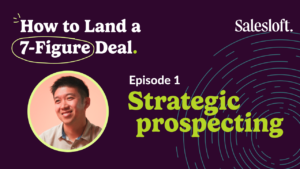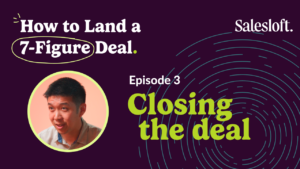In this three-part series, you’ll learn how a Salesloft AE lands multiple mega deals — from prospecting to selling to power, to delighting them as customers — so you can replicate his success.
In the first interview of How to land a 7-figure deal (link), Salesloft Enterprise AE Corey Goldstein outlined his prospecting approach for new buyers and existing customers. In this interview, Corey gets more tactical. The Interviewer, Albert Rhee, Salesloft’s Director of Product Marketing, sits with him to discuss even more big deal tactics for your team.
This interview has been edited for clarity.
Albert:
When you’re working a deal of this scale, how high up in the organization is it important to build relationships to make sure things go well?
Corey:
With some of these global companies, it’s gonna be tough to get the CEO. They’re almost untouchable. So as high as you can go is the easy answer, but how do you get there? A lot of the time, my title as Enterprise Account Executive or Strategic Account Executive is not gonna get me there, which is fine.
What I can do is empower our leadership. Whoever has a “C” before their title is typically helpful to go engage these people with a valuable message. The best thing that I can do is empower my C-suite leaders with the story, the value, and what the prospect cares about. So when the C-level execs at my company eventually get that meeting or they’re crafting the message to the potential customer, it makes sense — and it’s making the most out of the time that they have together.
Albert:
So when you’re building out your champions, as well as getting multithreaded accounts, does your role become even more complex? Do you have more champions? Do you rely heavily on just a few? What’s your plan of attack?
Corey:
My plan was to go as wide as possible, trying to touch everyone I possibly could, because who knows what’s going to happen next. Luckily for me, some of those people that I engaged with early on and consistently stayed in touch with were pushed up into the org to a place of influence and power. Now I was in a position where they knew me, they knew the value of what I was selling, we already had an established relationship. And once I was able to tie that strategic objective to what we can do, it was much easier to go after them.
But I think a big learning lesson for me was “don’t rely on one person” at any prospective company, because who knows if they’re going to be there tomorrow.
Albert:
How many detractors did you find yourself running into, and how did you handle each one of those?
Corey:
A ton. Political capital is not something light at these big companies.
When I come across a detractor, the first thing I always try to do — in life and also in business — is learn the perspective of someone who’s against me. Why? What’s their angle here? And then, how can I best fight that? Going head-to-head and fighting fire with fire isn’t going to work a lot of the time.
So an analogy I like to use a lot when it comes to competitors is with a tiger and a shark. If a tiger is fighting a shark on land, the tiger’s gonna win every time. That’s where they do their business. That’s where they live, on land. They can swim a little bit, but if they go into the water and they start to fight a shark, a shark is going to win.
So with competitors, I always tried to stay where I was more comfortable and not fight their fight. I chose instead to fight my fight where I was more comfortable, and bring that customer along where I knew we could win — not go over someplace with them where I thought there was a potential for us losing.
Albert:
What secrets, if any, did you deploy to advance your deals forward?
Corey:
A big part of what I tried to do was what we call “face in the place.” Get in front of these executives, coaches, champions, and decision makers in person. When we actually break bread or spend time in person, we really get to know each other.
So that’s where it helps to have coaches and champions within the org to ask, “Hey, when is leader A going to be in Dallas?”or “When are they going to be in Dublin or London?” Then you have to find a way to get there yourself on site, and serendipitously run into them. You can use that encounter to ask them if they’re available for a happy hour or a meetup later.
Create and use those sorts of opportunities to advance a deal forward, not too aggressively. It should feel natural.
Albert:
Tailoring your approach to an account or a person within a company that you’re trying to reach out to is pretty important. Do you take it to another level when you’re dealing with a potential 7-figure deal?
Corey:
So some of the things that I did was I asked my enterprise prospect, what’s your business case template? And have them send me over their template, and I put my business case in their template. That way, I can make sure that my messaging is aligned with the verbiage they used, which is important.
I think if you don’t know who their competitors are and you’re misspeaking, they don’t feel like you really know them. You don’t know their org. But if you’re using the same words, like how at Salesloft, we call ourselves Lofters. So if I was selling to Salesloft, I would say, “How many Lofters do you think would need a license?” Or saying “reps” or “sellers.” There’s so many acronyms for these companies. You have to use their acronyms. You have to know SDR versus BDR versus XDR, or even CSD for corporate sales development. Using the right verbiage, took me to the next step of decision makers really thinking, “Okay, Corey gets it. I trust him.” It lets them know that I understand the inner workings of their company.
Albert:
Why do you think, ultimately, that these accounts picked the offering that you put on the table?
Corey:
I think over time a lot of what it came down to is that I was obsessed. I was passionate. Luckily, I believe in the product I’m selling. Sometimes, when I was doing a presentation or I was in a meeting with them, I was so passionate about the fact that Salesloft could help them. I’m not trying to shove a product down your throat. I’m genuinely trying to help you. Here is literally the solution to the problem or challenge you’ve been trying to solve.
The obsession I went through to try to figure out what those problems and challenges actually were, and the belief that I knew that Salesloft could solve them was the X factor for getting customers to invest over a million dollars into our software to solve their problems.
Check out the rest of the series
Even in B2B sales, selling is still a human-to-human interaction. One that needs you to find a wide array of coaches and champions at your prospective org and that might need you to tap into your own C-suite for help, too. Corey still has a few more tactics to share, though, so don’t miss out. Read Albert’s previous interview below, then check out the third interview in the series. You’ll learn how to actually close a 7-figure deal and the patience it takes to lock one down. Then subscribe to our YouTube channel to get notified whenever we drop fresh sales advice.
 |
 |


